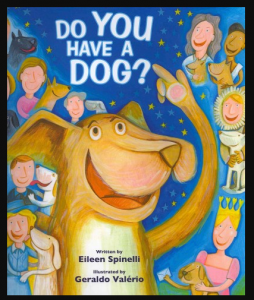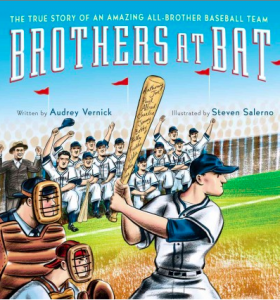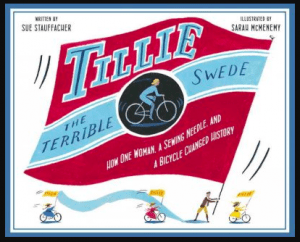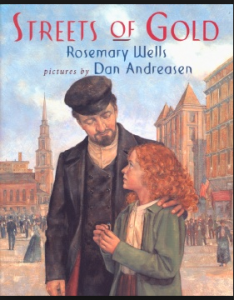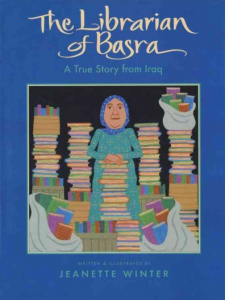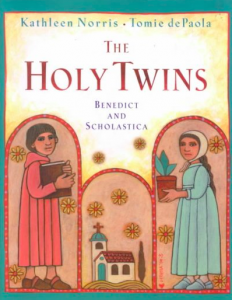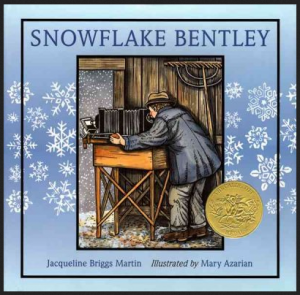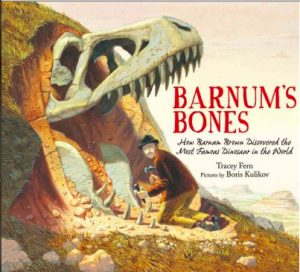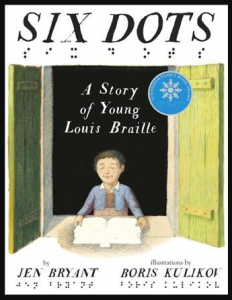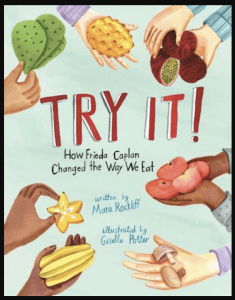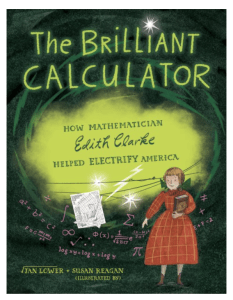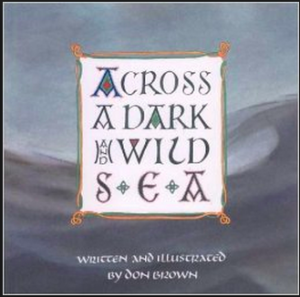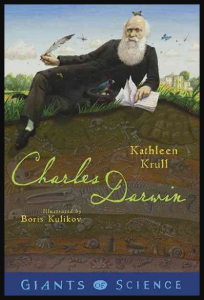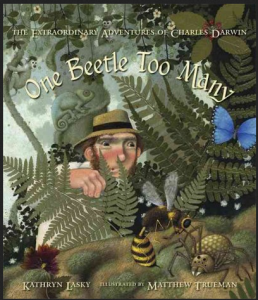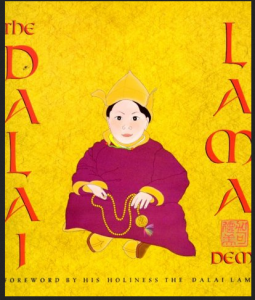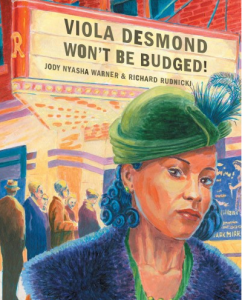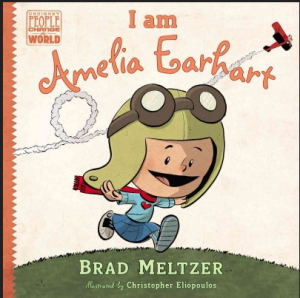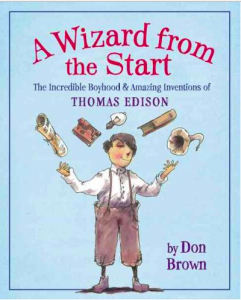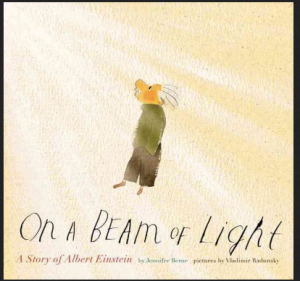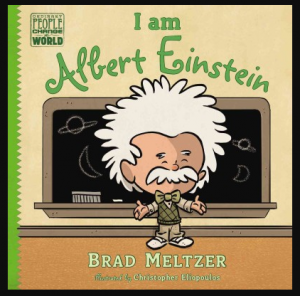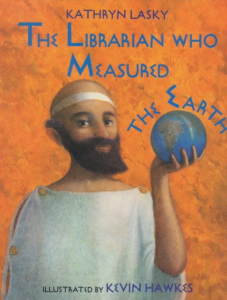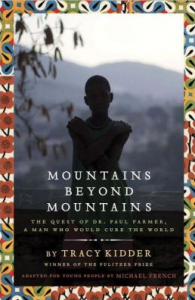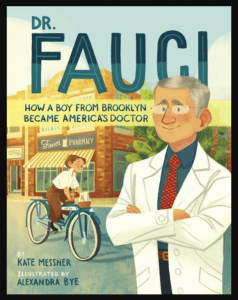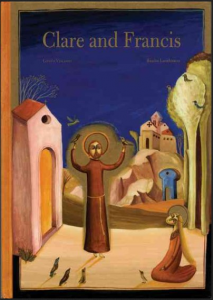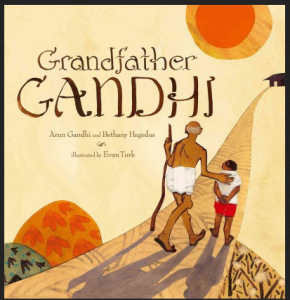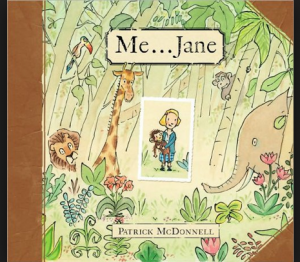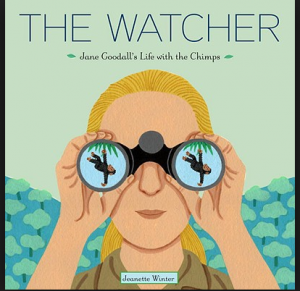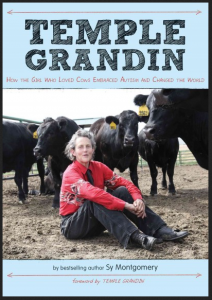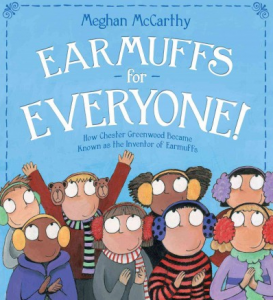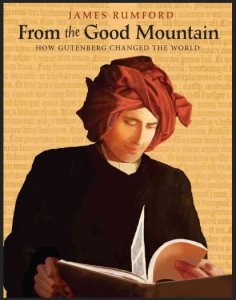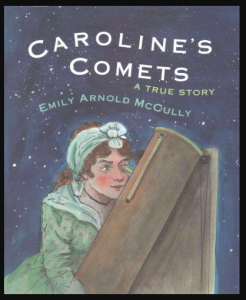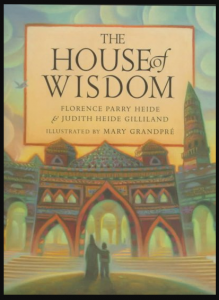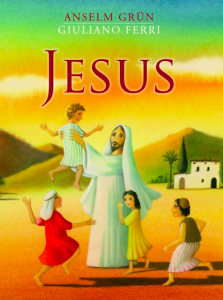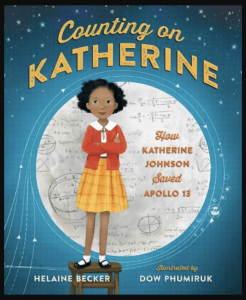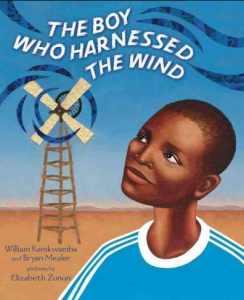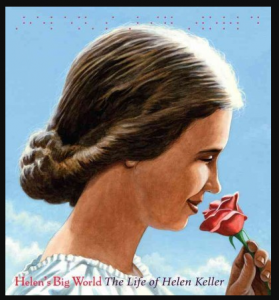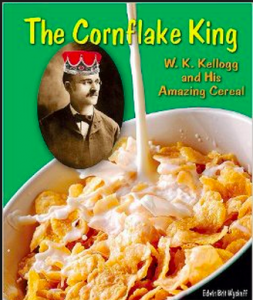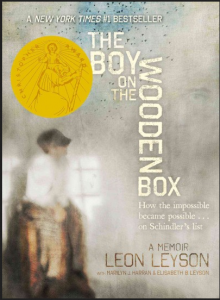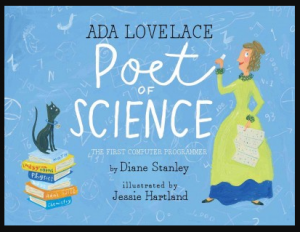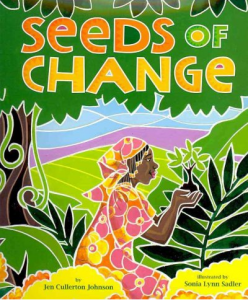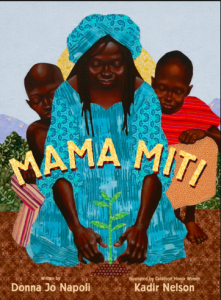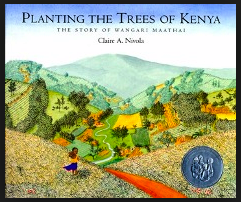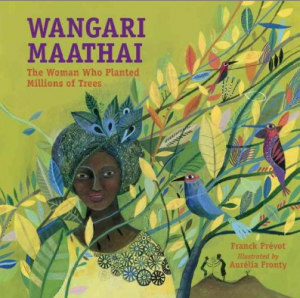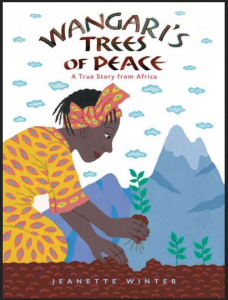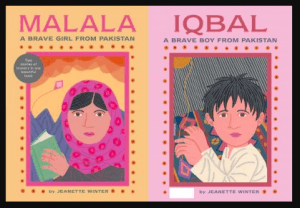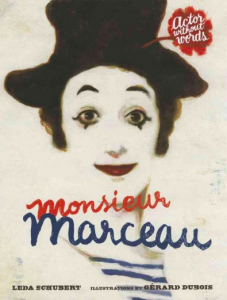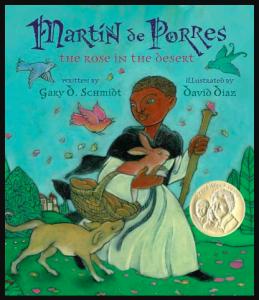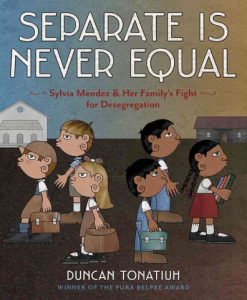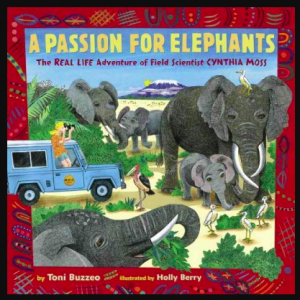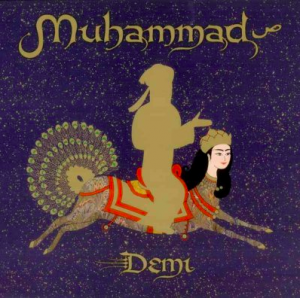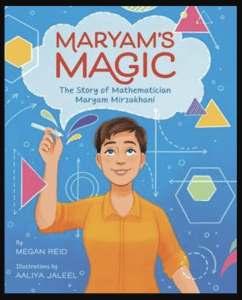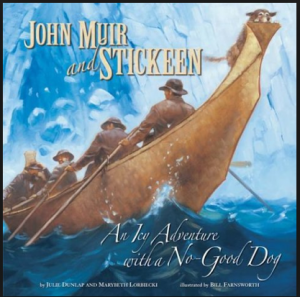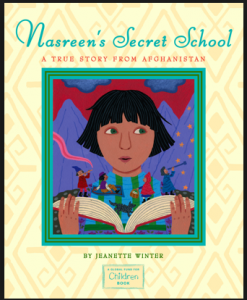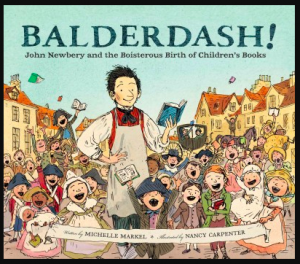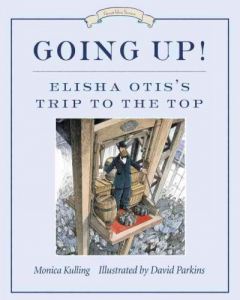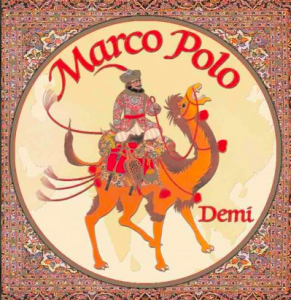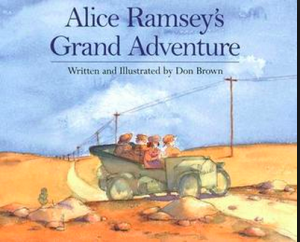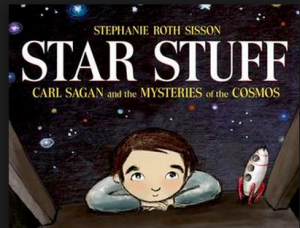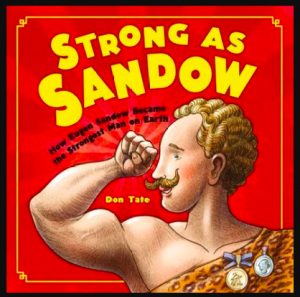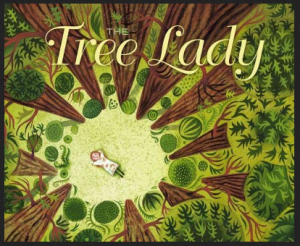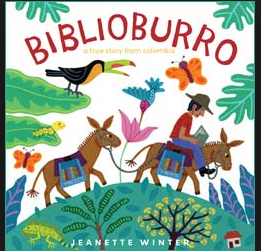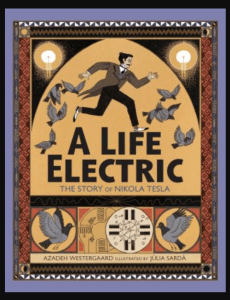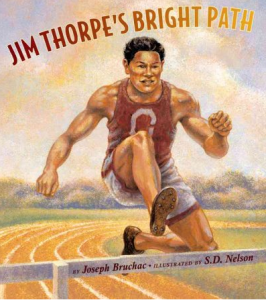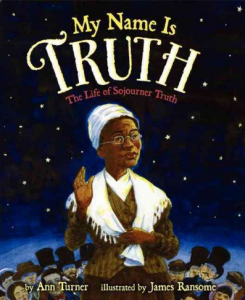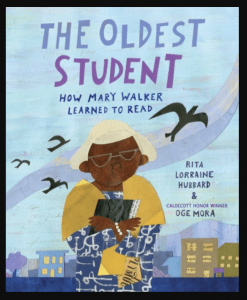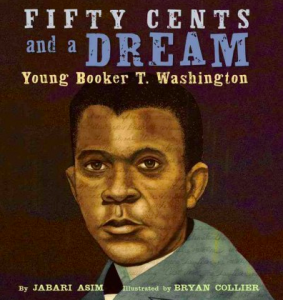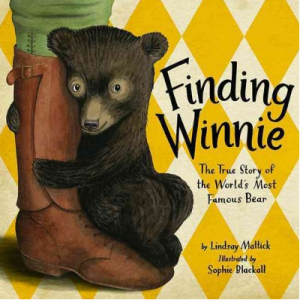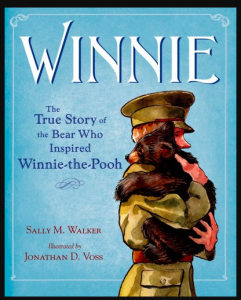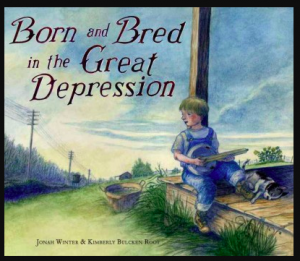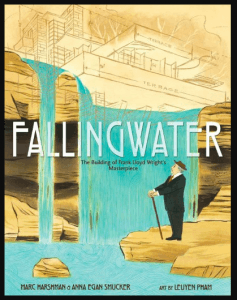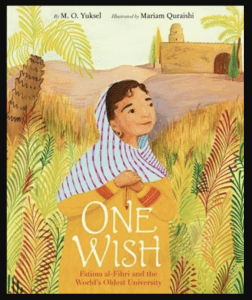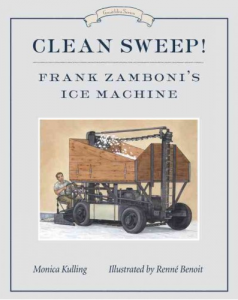Read about a Real Person
“The purpose of human life is to serve, and to show compassion and the will to help others.” Albert Schweitzer
Obama, Barack. Of Thee I Sing: A Letter to My Daughters. New York: Alfred A. Knopf, 2010.
“Have I told you?” asks the former president of the U.S. over and over again as he tells his daughters about heroes of American history: Georgia O’Keeffe, Albert Einstein, Jackie Robinson, Sitting Bull, Billie Holiday, Helen Keller, Maya Lin, Jane Addams, Martin Luther King Jr., Neil Armstrong, Cesar Chavez, Abraham Lincoln, and George Washington. Supplemented by additional information, this loving picture book – illustrated by Loren Long – is recommended for readers – and listeners – 5 to 14 years old.
Spinelli, Eileen. Do You Have a Dog? Grand Rapids, MI: Eerdmans Books for Young Readers, 2011.
Eleven historical figures who enjoyed dogs are featured in this picture book cheerfully illustrated by Geraldo Valério. Empress Josephine Bonaparte, Admiral Richard Byrd, Agatha Christie, Billie Holiday, Helen Keller, Meriwether Lewis, Sir Isaac Newton, Annie Oakley, Jackson Pollock, Franklin Delano Roosevelt, and Orville Wright. Happily recommended for young listeners and older reluctant readers. [Biographies; Dogs; Stories in rhyme]
A
Brothers at Bat: The True Story of an Amazing All-brother Baseball Team by Audrey Vernick (Boston: Clarion Books, 2012).
“Documents the story of the Baseball Hall of Fame honorees, tracing how the Acerra family of New Jersey formed their own semi-pro baseball team in the 1930s and became the longest-running all-brother team in history.” – CIP. Recommended for sports lovers 11 to 14-years-old.
Alex the Parrot: No Ordinary Bird: A True Story by Stephanie Spinner (Alfred A. Knopf, 2012).
The story of Alex the African Grey parrot and Irene Pepperberg, who proved that birds were more intelligent than people thought. – flyleaf [Birds; Parrots; Scientists]
…
Alexander the Great by Demi (Marshall Cavendish, 2010).
Alexander the Great: Master of the Ancient World by Doug Wilhelm (Scholastic, 2010).
Stauffacher, Sue. Tillie the Terrible Swede: How One Woman, a Sewing Needle, and a Bicycle Changed History. New York: Alfred A. Knopf, 2011.
“I read Tillie the Terrible Swede, a picture book about a girl who left Sweden to come to America. Most girls came to America with a dream. Tillie [Anderson] was no different. But all she had was a needle. So she worked in a tailor shop and waited for a dream to come find her. One day, a man sped by her shop on a bicycle. Now she had a dream! She dreamed of riding a bicycle, too. But girls were not allowed to ride bicycles. Tillie proved that they could. This picture book biography is recommended for girls who want to be inspired to make a difference in their own world.” – Avneet, grade 6
…
Streets of Gold by Rosemary Wells (Dial Books for Young Readers, 1999).
Over 100 years ago, in 1894, Mary Antin’s family left Russia, where Jewish people were persecuted, and came to New York City. Young Mary learned English and wrote about her experiences in The Promised Land. Now Rosemary Wells – famous for writing her own books – has retold Mary’s story in this powerful picture book suitable for readers nine years old and up.
…
B
McDaniel, Breanna J. Go Forth and Tell. New York: Dial Books for Young Readers, 2024.
This gorgeous picture book – illustrated by April Harrison – tells the story of Augusta Baker, a little girl who loved listening to her grandmother’s stories and who grew up to become a teacher who loved telling her own stories, as well as the first African American librarian to be head of children’s services in the New York Public Library system. Highly recommended for readers of any age who like telling stories and creating works of art.
Samuel, Sigal. Osnat and Her Dove: The True Story of the World’s First Female Rabbi. Montclair, New Jersey : Levine Querido, 2021.
Almost five hundred years ago in the city of Mosul, a little girl grew up learning how to read. How astonishing! Girls were supposed to do household chores, not study books. But Osnat’s father – a respected rabbi – was willing to teach his daughter how to decipher the Hebrew letters of the Torah. She poured herself into studying and when it was time to get married, she accepted a husband only on the condition that she could keep studying. Eventually, she became a teacher of the Torah and finally the head of a yeshiva. Today, legends are told in Iraq about the miraculous woman who became the first rabbi in history. [Barzani, Osnat; Iraq – History]
The Librarian of Basra: A True Story from Iraq by Jeanette Winter (Harcourt Children’s Books, 2005).
Grass Sandals: The Travels of Basho by Dawnine Spival and illustrated by Demi (Atheneum Books for Young Readers, 1997).
The Holy Twins: Benedict and Scholastica by Kathleen Norris and illustrated by Tomie dePaola (New York: G.P. Putnam’s Sons, 2001).
…
Snowflake Bentley by Jacqueline Briggs Martin (Boston: Houghton Mifflin, 1998).
A biography of a self-taught scientist who photographed thousands of individual snowflakes in order to study their unique formations.” – CIP
Barnum’s Bones: How Barnum Brown Discovered the Most Famous Dinosaur in the World by Tracey Fern (New York: Barrar Straus Giroux, 2012).
A fascinating account of the discoveries of a famous paleontologist. Sure to be enjoyed by anyone who wonders how scientists know what dinosaurs looked like. Recommended for readers 10-years-old and up.
Biebow, Natascha. The Crayon Man. Boston: Houghton Mifflin Harcourt, 2019.
Coloured oil pastel pencils were invented in 1834 by the Staedtler company. Coloured art pencils were invented in 1924 by Faber-Castell and Caran d’Ache. In between those two dates – in 1903 – coloured wax crayons were invented by Edwin Binney, a man who loved colour. Binney had already invented an inexpensive gray slate pencil and a white chalk pencil that wasn’t dusty. He’d invented a wax crayon, but it was black and he wanted colour. So he and a team experimented using ground up rocks and minerals. They tried adding clay and wax. They tried heating the mixtures and letting them slowly cool. Finally, they were ready with a box of eight: blue, brown, green, orange, red, violet, yellow, and – of course – black. Crayola crayons became famous!
Supplemented by a two-page illustrated step-by-step explanation of how crayons are still made in Pennsylvania, a one-page biography of additional information about Binney, and a bibliography for curious readers, this picture book is happily recommended for readers six to eleven years old.
P.S. As a source of information for students doing research to expand their general knowledge, this book is great. As a read-aloud for young children, it will still be interesting but the small boxes of additional information in a smaller font on six of the pages disrupt the flow of the story. I wish that the author had found a way to either include the information in the main text or put it in an appendix. I also wish the designer of the book had chosen a more cheerful font for the story. But otherwise, this is a wonderful biography to encourage readers to be curious about the everyday objects all around them.
Six Dots: A Story of Young Louis Braille by Jen Bryant (New York: Alfred A. Knopf, 2016).
Energetic, impetuous, determined, brilliant. This picture book biography – illustrated by Boris Kulikov – of the young boy who grew up to invent a way for blind people to read is highly recommended for readers of all ages. An author’s note, additional information about Louis Braille, and a bibliography and list of websites are provided at the end of the story.
The Story of Ruby Bridges by Robert Coles (New York: Scholastic Inc., 1995).
A picture book account of the first African-American student, a six-year-old girl, in a New Orleans elementary school in 1960.
…
C
Rockliff, Mara. Try It! How Frieda Caplan Changed the Way We Eat. New York: Beach Lane Books, 2021.
Kiwifruit, spaghetti squash, sugar snap peas. Those foods are now common in grocery stores. But it wasn’t always that way. In the 1960s, a woman in California changed people’s eating habits. She started her own produce company and introduced buyers to purple potatoes, artichokes, and habanero peppers. Blood oranges, Asian pears, and seedless watermelons. Frieda Caplan was an adventurer and happily brought the world to her customers. This informative picture – with an afterword providing more details – will appeal to listeners and readers 6 to 12 years old. (Teachers: this book would make a great introduction to a nutrition unit and could be followed by a chance for students to taste test various less familiar fruits and vegetables.)
Lower, Jan. The Brilliant Calculator: How Mathematician Edith Clarke Helped Electrify America. New York: Calkins Creek, an imprint of Astra Books for Young Readers, 2023.
Edith Clarke was born in 1883 and grew up loving numbers, excelling at school math competitions. She was sent to boarding school to learn about manners and music but instead dreamed of building railroads and bridges. After attending college, she became a math and physics teacher and helped invent a slide rule to speed up math calculations. She studied engineering, designed electrical transmission lines, and invented a calculator to help other engineers provide electricity for people all across America. All this information is told as a smoothly flowing story, in short sentences comfortable for reading silently or aloud. Extensive additional information is included at the end: an author’s note; a timeline; a glossary; a descriptive list of eight more women mathematicians, engineers, and inventors; and a lengthy bibliography. A beautifully designed and illustrated biography highly recommended for readers 9 to 90 years old.
…
Across a Dark and Wild World written and illustrated by Don Brown (Brookfield, Conn.: Roaring Brook Press, 2002).
This picture book biography by a renowned author and illustrator is based on the legend of Columcille, an Irish monk whose love books helped save learning during Europe’s Dark Ages.
…
The Fantastic Undersea Life of Jacques Cousteau by Dan Yaccarino (Alfred A. Knopf, 2009).
Marie Curie by Kathleen Krull (Viking, 2007).
…
D
Charles Darwin by Kathleen Krull (Penguin Group, 2010).
One Beetle Too Many: The Extraordinary Adventures of Charles Darwin by Kathryn Lasky (Candlewick Press, 2009).
” Text and illustrations tell the story of the ever-curious boy who grew up to make one of the most significant discoveries of our time.” – CIP
Charles and Emma: The Darwins’ Leap of Faith by Deborah Heligman (H. Holt, 2010, 2009).
Winner of multiple awards, this biography tells the story of Charles Darwin and his marriage to the woman who encouraged him to explore his ideas and develop his scientific theories. Intelligent readers who prefer books about the real world will enjoy this elegantly written biography of the man who first published his revolutionary ideas on evolution in 1859. [Darwin, Charles; Darwin, Emma Wedgewood; Evolution (Biology) — Biography; Naturalists]
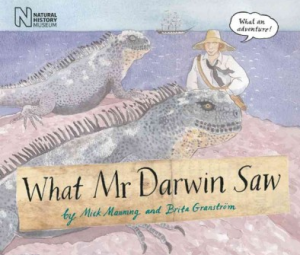 What Mr. Darwin Saw by Mick Manning and Brita Granstrom (London : Frances Lincoln Children’s, 2009).
What Mr. Darwin Saw by Mick Manning and Brita Granstrom (London : Frances Lincoln Children’s, 2009).
 The Tree of Life : A Book Depicting the Life of Charles Darwin, Naturalist, Geologist & Thinker by Peter Sis (Toronto: Douglas & McIntyre, 2003).
The Tree of Life : A Book Depicting the Life of Charles Darwin, Naturalist, Geologist & Thinker by Peter Sis (Toronto: Douglas & McIntyre, 2003).
…
Leonardo da Vinci by Kathleen Krull (Puffin Books, 2005).
Leonardo Da Vinci: Young Artist, Writer, and Inventor by George E. Stanley (Aladdin Paperbacks, 2005).
This great Renassiance painter started life in a small town in Italy. Rejected by his parents, sent to live with his grandparents, he became an apprentice to a famous artist while still a young teenager. He worked hard and soon became not only a master artist, himself, but also an outstanding architect, sculptor and scientist. Part of the series Childhood of World Figures, this biography has an AR reading level of 6.0.
…
Neo Leo: the Ageless Ideas of Leonardo da Vinci by Gene Barretta (Christy Ottaviano Books/Henry Holt and Company, 2009).
…
Boy on the Lion Throne: The Childhood of the 14th Dalai Lama by Elizabeth Cody Kimmel (Roaring Brook Press, 2008).
The Dalai Lama : A Biography of the Tibetan Spiritual and Political Leader by Demi (Henry Holt, 1998).
Viola Desmond Won’t Be Budged! by Jody Nyasha Warner (Toronto: Groundwood Books, 2010). The story of an African Canadian who refused to give up her seat in a movie theatre and move to the balcony reserved for black patrons. This courageous act in Nova Scotia in 1946 started the move to end racial segregation in Canada. Illustrated by Richard Rudnicki and accompanied by additional historical information at the end, this picture book is recommended for readers 8-years-old and up and could be compared to the story of Rosa Parks in America.
…
E
I Am Amelia Earhart by Brad Meltzer (New York: Dial Books for Young Readers, 2014).
…
Brown, Don. A Wizard from the Start : the Incredible Boyhood & Amazing Inventions of Thomas Edison. New York: Houghton Mifflin Books for Children, 2010.
“From his humble boyhood as a farmer’s son, selling newspapers on trains, reading through public libraries shelf by shelf, and dreaming of new inventions, Thomas Edison went on to create the light bulb, the phonograph, and the motion picture camera.” – CIP
On a Beam of Light: A Story of Albert Einstein by Jennifer Berne (Chronicle Books, 2013).
Albert Einstein by Kathleen Krull (Viking, 2009).
I Am Albert Einstein by Brad Meltzer (New York: Dial Books for Young Readers, 2014).
This small biography is part of the charming picture book series ‘Ordinary People Change the World’. Told from the first person point of view and illustrated in cartoon style by Christopher Eliopoulos, each volume focuses on a specific character trait. In this story, the focus is curiosity. Black and white photos of Einstein, a time line, and a bibliography conclude this biography recommended for readers 8 to 14 years old. [Einstein, Albert; Physicists]
…
The Librarian Who Measured the Earth by Kathryn Lasky (Boston: Joy Street Books, 1994).
“Describes the life and work of Eratosthenes, the Greek geographer and astronomer who accurately measured the circumference of the Earth.” – CIP. Illustrated by Kevin Hawkes.
…
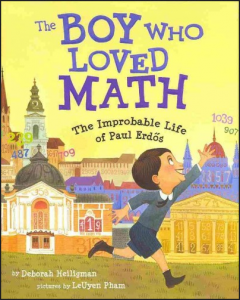
The Boy Who Loved Math : the Improbable Life of Paul Erdős by Deborah Heiligman (New York: Roaring Brook Press, 2013).
“Growing up in Hungary during WWI, Erdos tried school but chafed at the rules and convinced his mother that he should study at home. He was fascinated by numbers from an early age, and by the time he was 20, he was known as The Magician from Budapest. Unable to do common tasks such as cooking, laundry, or driving, he spent his adult life flying around the world, staying with other mathematicians, and working collaboratively on challenging math problems.” – CIP.
…
F
Mountains Beyond Mountains: The Quest of Dr. Paul Farmer, A Man Who Would Cure the World by Tracy Kidder; adapted for young people by Michael French (New York: Delacorte Press, 2013).
Paul Farmer, a medical doctor educated at Harvard University, has devoted his life to helping poor people in Haiti and around the world. A detailed biography for readers 12 years old and up.
Dr. Fauci: How a Boy from Brooklyn Became America’s Doctor by Kate Messner. (New York: Simon & Schuster Books for Young Readers, 2021.)
A straight-forward picture book biography – with extensive additional information, including information on how vaccines are developed, a reading list, a timeline, and numerous photographs – for curious readers 6 to 11 years old. Useful for classroom discussions and as a springboard to research. Recommended for its timeliness.
Ben Franklin’s Big Splash: the Mostly True Story of His First Invention by Barb Rosenstock (Honesdale, Pennsylvania: Calkins Creek, 2014).
Ben sprints, stomps, splashes, sloshes, shakes and smiles in this rollicking picture book biography cheerfully illustrated by S.D. Schindler. The varying fonts and layout on each page help create a story that will be enjoyed by readers 7 to 14 years old. (Additional information, including a timeline of Benjamin Franklin’s life, is provided at the end of the book.)
“An investment in knowledge pays the best interest.” – Ben Franklin
Stone, Tanya Lee. Remembering Rosalind Franklin. New York: Christy Ottaviano Books / Little, Brown and Company, 2024.
Who discovered the double helix structure of DNA? James Watson and Francis Crick won a Nobel Prize for the discovery in 1962. But it was Dr Rosalind Franklin’s work using X-ray diffraction that revealed that double-helix structure of deoxyribonucleic acid. It was her photograph that showed the molecule with the genetic instructions for the development of life. This well-designed 40-page picture book biography by an award-winning writer tells the story of an intelligent and inquisitive scientist who sadly never received recognition during her lifetime. Illustrated by Gretchen Ellen Powers and accompanied by an afterward describing the the historical tendency for women’s achievements to be overlooked, it is highly recommended for inquisitive readers 11 years old and up.
…
Clare and Francis by Guido Visconti (Eerdmans Books for Young Readers, 2004, c2003).
Saint Francis by Brian Wildsmith (Wm. B. Eerdmans Pub., 1996).
Click HERE for books about Anne Frank.
Ben Franklin’s Big Splash: the Mostly True Story of His First Invention by Barb Rosenstock (Honesdale, Penn.: Calkins Creek, 2014).
…
G
Gandhi by Demi (Margaret K. McElderry Books, 2001).
Grandfather Gandhi by Arun Gandhi and Bethany Hegedus (Atheneum Books for Young Readers, 2014).
Genghis Khan: 13-Century Mongolian Tyrant by Enid A. Goldberg (Scholastic, 2008).
…
Me…Jane by Patrick McDonnell (Little, Brown and Co., 2011).
The Watcher: Jane Goodall’s Life with the Chimps by Jeanette Winter (Schwartz and Wade, 2011).
…
Temple Grandin: How the Girl Who Loved Cows Embraced Autism and Changed the World by Sy Montgomery (Boston: Houghton Mifflin Books for Children/Houghton Mifflin Harcourt, 2012).
Earmuffs for Everyone! : How Chester Greenwood became Known as the Inventor of Earmuffs by Meghan McCarthy (New York: Simon & Schuster Books for Young Readers, 2015).
A cheerful and colourful picture book about a boy came up with a great idea for keeping his ears warm during cold Maine winters during the late 1800s. Accompanied by historical information and a bibiography. Highly recommended for everyone 8-years-old and up who enjoys expanding their general knowledge.
…
From the Good Mountain: How Gutenberg Changed the World by James Rumford (New York: Roaring Brook Press, 2012).
…
H
My Childhood Under Fire: A Sarajevo Diary by Nadja Halilbegovich (Kids Can Press, 2006).
Jimi: Sounds Like a Rainbow: A Story of the Young Jimi Hendrix by Gary Golio (Clarion Books, 2010).
Keep On! The Story of Matthew Henson, Co-discoverer of the North Pole by Deborah Hopkinson, Peachtree, 2009.
Caroline’s Comets: A True Story by Emily Arnold McCully. New York: Holiday House, 2017.
Caroline Herschel was born in Germany in 1750. Her father and brothers were musicians but she – being a girl – was kept busy doing housework. Everything changed when she was 22 years old. She joined her older brother in England and became a professional singer and then an assistant to her brother, who had become an astronomer for King George III. Later, she also earned a salary as an astronomer for the king. Before she died in 1848, she had discovered 8 comets and become a star among scientists.
Quotations from Caroline’s diary are embedded in this incredible story of the first woman to discover a comet. The gently old-fashioned pen, ink, and watercolour illustrations enhance this picture book biography for readers 9 years old and up.
…
Of Numbers and Stars by D. Anne Love (Holiday House, 2006).
Almost 2000 years ago in Egypt, in the famous city of Alexandria, a girl was born who would grow up to be a teacher renowned for her knowledge of science, mathematics and philosophy. People came from all over to learn from her and to seek her advice. Unfortunately, eventually, more powerful people in Alexandria became displeased with her independent thinking. This gently illustrated and informative picture book biography tells Hypatia’s (Hi-PAY-shu’s) story in a style reminiscent of Miss Rumphius by Barbara Cooney and is suitable for readers – and listeners – aged eight to eighty. [Egypt, Ancient; Hypatia; Mathematicians; Philosophers]
…
I
The House of Wisdom by Florence Parry Heide and Judith Heide Gilliland (New York: DK Ink, 1999).
Long ago, during the Dark Ages in Europe, knowledge flourished in the Arabic-speaking world. Baghdad became the centre of a great civilization that made lasting discoveries in cartography, geography, mathematics, chemistry, medicine, and philosophy. Scholars gathered to study together and translate foreign documents in what was the largest library in the world.
Ishaq, the main character in this picture book biography, travels to far-away lands and returns with thousands of books and manuscripts He later goes on to translate all the works of Aristotle into Arabic. Later still, those Arabic translations would help inspire the European Renaissance.
Softly coloured illustrations by Mary GrandPré, additional historical information, a timeline, and a map enhance this quietly adventurous biography for readers 9 years old and up.
J
Jesus by Anselm Grun (Grand Rapids, Michigan: Eerdmans Books for Young Readers, 2014).
An easy-to-read biography with gentle full-page illustrations. Recommended for readers 9-years-old and up.
Jesus by Brian Wildsmith (Eerdmans Books for Young Readers, 2000).
Red Scarf Girl: A Memoir of the Cultural Revolution by Ji-li Jiang ( HarperCollins, 1997).
Joan of Arc by Demi (Marshall Cavendish, 2011).
Becker, Helaine. Counting on Katherine: How Katherine Johnson Saved Apollo 13. New York: Henry Holt and Company, 2018.
Katherine was a child who loved numbers. But in the 1920s and ’30s, girls did not grow up to become mathematicians. So Katherine became a school teacher. Until in the 1950s, she finally got a chance to work for America’s National Advisory Committee on Aeronautics. For 35 years, her calculations of flight-paths helped to safely send astronauts around the world, to the moon, and back again to Earth. She died on February 24, 2020 at 101 years of age. This picture book illustrated by Dow Phumiruk is highly recommended for curious readers 9 years old and up.
…
K
The Bite of the Mango by Mariatu Kamara (Annick Press, 2008).
A powerful autobiography – for mature readers 14-years-old and older – about a woman who came to Canada. [Amputees; Sierra Leone; War victims]
The Boy Who Harnessed the Wind by William Kamkwamba and Bryan Mealer (New York: Dial Books for Young Readers, 2012).
In 2001, William Kamkwamba’s village suffered from a drought. His starving family could not afford to send him to school but he did not give up learning. In the local library, he read a book about windmills. He decided to build his own windmill. Amazingly, he was successful! He found a way to bring electricity to his village, and a way to use that electricity to provide irrigation to water crops for his village. This picture book, beautifully illustrated by Elizabeth Zunon, is highly recommended for readers 8 years old and up. (Africa; Electricity; Ingenuity; Inventors; Irrigation; Malawi; Mechanical engineers; Poverty; Windmills)
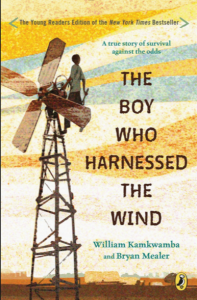
The Boy Who Harnessed the Wind by William Kamkwamba and Bryan Mealer (New York: Puffin Books, 2015).
Young William was born in 1987 to a farming family in Malawi. Too poor to pay school fees, he had to stay home rather than continuing his education. But he did not stop learning. He found books in a small library and figured out how to build a device that created electricity. This 293-page autobiography – a longer version of the picture book shown above – of an intrepid and determined boy will inspire readers 11-years-old and up. Highly recommended.
…
Helen’s Big World: The Life of Helen Keller by Doreen Rappaport (New York: Disney/Hyperion Books, 2012).
What a beautifully designed biography! Each double-page spread includes information written in the style of narrative poetry, a Helen Keller quotation in larger print, and a huge coloured painting illustrating the quotation. An author’s note, illustrator’s note, list of important dates, bibliography, and list of suggested additional reading conclude this highly recommended picture book for readers – and listeners – 6 to 14 years old. [Deafblind people; Determination; Keller, Helen – Biography; Sullivan, Annie]
…
The Cornflake King: W.K. Kellogg and His Amazing Cereal by Edwin Brit Wyckoff (Enslow Publisher, 2011).
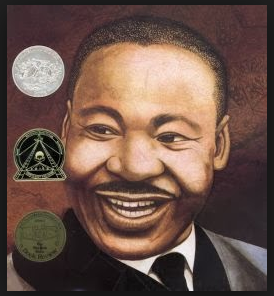
Martin’s Big Words: the Life of Martin Luther King, Jr. by Doreen Rappaport (New York : Jump at the Sun/Hyperion Books for Children, 2001).
The Champion of Children: The Story of Janusz Korczak by Tomek Bogacki (Farrar Straus Giroux, 2009).
Kubla Khan: The Emperor of Everything by Kathleen Krull (Viking, 2010).
…
L
The Boy on the Wooden Box: How the Impossible became Possible…on Schindler’s List: a Memoir by Leon Leyson (New York : Atheneum Books for Young Readers, 2013).
I am Abraham Lincoln by Brad Meltzer (New York: Dial Books for Young Readers, 2014).
The Stars Come Out Within by Jean Little (Penguin, 1990).
No Pretty Pictures: A Child of War by Anita Lobel (Greenwillow Books, 1998).
Ada Lovelace: Poet of Science : the First Computer Programmer by Diane Stanley (New York: Simon & Schuster Books for Young Readers, 2016).
What a brilliant biography! The style of writing is lively and humorous! The illustrations by Jessica Hartland enhance the mood and extend the story. The story is engaging, and additional information – including a bibliography and glossary – is found at the end of the book. Highly recommended for all ages. [Babbage, Charles; Lovelace, Ada King, Countess of; Mathematicians; Women computer programmers]
…
M
Seeds of Change: Planting a Path to Peace by Jen Cullerton Johnson (Lee & Low Books, 2010).
Mama Miti: Wangari Maathai and the trees of Kenya by Donna Jo Napoli (Simon & Schuster Books for Young Readers, 2010).
Planting the Trees of Kenya: the Story of Wangari Maathai by Claire A. Nivoli (Frances Foster Books/Farrar, Straus and Giroux, 2008).
Wangari MaathaI: the Woman Who Planted Millions of Trees by Franck Prevot (Charlesbridge, 2015).
“I read an outstanding book called Wangari Maathi by Frank Prévot. Wangari Maathi was born in Kenya at a time when girls normally did not attend school. So she helped her mom at home: gathering wood for the fire, looking after her siblings, and doing farm chores. One evening, her mother decided that her daughter should be educated. So Wangari went to school and earned a high school diploma at a time when some African women did not even know how to read. Wangari then moved to the United Stated for further studies. When she returned to Kenya five years later, everything had changed She saw Kenyans cutting down trees so they could use the land to grow tea, coffee, and tobacco wanted by rich countries. Wangari was shocked. She decided to take action. She started the Green Belt Movement, gathering a team of people and planting hundreds of trees. She was imprisoned several times because she took action against the government but every time she was released, she fought more. She did not give up. What a positive impact she had on her community! She was courageous and brave and believed in a better future for Kenya. Wangari eventually wond the 2004 Nobel Peace Prize award for all her hard work.” – Avneet, grade 6
Wangari’s Trees of Peace: a True Story from Africa by Jeanette Winter (Harcourt, 2008).
Maslo, Lina. Free as a Bird: The Story of Malala. New York: Balzer & Bray an imprint of HarperCollinsPublishers, 2018.
McCarney, Rosemary. Every Day is Malala Day. Toronto: Second Story Press, 2014.
Winter, Jeanette. Malala, A Brave Girl from Pakistan; Iqbal, A Brave boy from Pakistan. New York: Beach Lane Books, 2014.
Monsieur Marceau by Leda Schubert (New York: Roaring Brook Press, 2012). [Marceau, Marcel; Mimes; France)
Schmidt, Gary D. Martin de Porres: The Rose in the Desert. Boston: Clarion Books, 2012.
His father was a Spanish nobleman. His mother was a slave. Born into poverty and sent to work as a servant, there was no bright future for Martin. But miracles happen. And miracles followed this boy from Peru. The lemon trees he planted bore fruit all year long. The bread he gave to the poor never ran out until everyone was fed. The people he treated were healed. He quietly died in a monastery in 1639, but miracles continued and he was named as the first black saint in the Americas in 1962. Born to be forgotten, Martin de Porres is now known as the patron saint of social justice. This beautiful picture book biography – illustrated by David Diaz – is highly recommended for people of faith and for all those who carry within themselves a reverence for mystery.
Heroes for My Son by Brad Meltzer (HarperStudio, 2010).
Separate Is Never Equal: Sylvia Mendez & Her Family’s Fight for Desegregation by Duncan Tonatiuh (New York: Abrams Books for Young Readers, 2014).
In California in 1944, Mexican children had to go to separate schools. Sylvia Mendez’s family began a fight for true equality and in 1947, the law was changed. Children of all cultural backgrounds were finally allowed to go to the same schools. Includes lengthy background information, historical photographs, a glossary, bibliography and index at the end. The design of the this picture book – the vivid illustrations and easy-to-read font – enhance this important story highly recommended for readers 9-years-old and up.
Alary, Laura. The Astronomer Who Questioned Everything: The Story of Maria Mitchell. Toronto: Kids Can Press, 2022.
Two hundred years ago on Nantucket, a little girl grew up with parents who believed both boys and girls should be educated. Her father was a schoolteacher and an astronomer and her mother had been a librarian, so it is not surprising that Maria and her nine siblings were encouraged to learn and think for themselves. Maria, a daydreamer, grew up to become a teacher and a librarian who loved challenges. When the King of Denmark offered a prize to the first person who could find a new comet, Maria determinedly looked through her telescope night after night until she spied a new comet. She won! Now she was famous and was soon invited to be a professor of astronomy. Maria spent the rest of her life encouraging her students to explore the skies and ask questions. Additional biographical information and a bibliography accompany this picture book cheerfully illustrated by Ellen Rooney. Highly recommended for readers 8 to 14 years old who enjoy true stories about historical figures.
P.S. The author’s combination of short and long sentences and sentence fragments creates a lovely rhythm for reading aloud. So lovely that it almost seems a shame to read the story silently. But the style of font is unfortunately not so lovely: the print is too serious and too small for the pictures. But that’s a minor fault compared to the beauty of the illustrations and the flow of the words. If you want a happy story that encourages patient persistence, read this book.
Buzzeo, Toni. A Passion for Elephants: The Real Life Adventures of Field Scientist Cynthia Moss. New York: Dial Books for Young Readers, 2015.
Cynthia Moss was not afraid of big things. Born in 1940, she grew up to become on of the most important elephant researchers in the whole world. This colourfully illustrated picture book will be appreciated by readers – and listeners – 7 to 14 years old. The smoothly flowing language and cheerful pictures will inspire writers and artists to create their own works of art. The courage and determination portrayed in this biography will encourage everyone to work hard to reach their goals in life.
Mother Teresa: Friend to the Poor by Kathleen Kudlinski (Aladdin Paperbacks, 2006).
Born in a small village in eastern Europe in 1910, Agnes Gonxha Bojaxhiu knew that she wanted to devote her life to helping people by the time she was twelve years old. And she did. Learn about the life of this famous humanitarian who was awarded the Nobel Peace Prize for her work among the poorest of the poor in countries around the world. Part of the series Childhood of World Figures, this biography has an AR reading level of 4.6.
Muhammad by Demi (Margaret K. McElderry Books, 2003).
…
Reid, Megan. Maryam’s Magic: The Story of Mathematician Maryam Mirzakhani. New York: Balzer + Bray, 2021.
Are you a numbers person? Do you enjoy working with equations? Or are you a word person? Do you like reading and writing? Or do you like both mathematics and stories?
Maryam preferred stories. Until – when she was 12 years old – she discovered geometry. Now she could turn numbers into shapes! And shapes made stories! This inspiring picture book biography tells the story of the first woman and first Iranian to win the prestigious Fields Medal, the mathematical equivalent of the Nobel Prize. Accompanied by additional facts and references at the end, it is recommended for readers 7 to 11 years old.
John Muir and Stickeen: An Icy Adventure with a No-Good Dog by Julie Dunlap and Marybeth Lorbiecki (NorthWord Press, 2004).
…
N
Nasreen’s Secret School: A True Story from Afghanistan by Jeanette Winter (Beech Lane 2009).
…
Balderdash! John Newbery and the Boisterous Birth of Children’s Books by Michelle Markel. San Francisco: Chronicle Books, 2017.
Wow! What a quietly rambunctious biography! Created by two award winners – author Michelle Markel and illustrator Nancy Carpenter – this picture book tells the story of an English farm boy who grew up to create the first magazines and novels especially for children. Readers of graphic novels will enjoy the details in the illustrations. Avid readers will find the story fascinating. Additional information and a bibliography are provided at the end. Highly recommended!
Isaac Newton by Kathleen Krull (Viking, 2006).
The Legend of Saint Nicholas by Demi (Margaret K. McElderry Books, 2003).
…
O
Going Up!: Elisha Otis’s Trip to the Top by Monica Kulling (Toronto: Tundra Books, 2012).
An informative and inspiring picture book for readers 11 to 14-years-old. [Elevators; Inventors; Otis, Elisha Graves]
…
P
I am Rosa Parks by Brad Meltzer (New York: Dial Books for Young Readers, 2014).
Patrick: Patron Saint of Ireland by Tomie DePaola (Holiday House, 1992).
“A lyrical biography, accompanied by the author’s inimitable illustrations, of the famous saint of Ireland.” – CIP
The Man Who Walked Between the Towers by Mordecai Gerstein (Heshan City: Square Fish, 1993).
The Man Who Walked Between the Towers by Mordicai Gerstein (Square Fish, 2003), is the story of Philippe Petit, a young man who lived in New York City in 1974, while the World Trade Center- two buildings, side by side, one thousand three hundred forty feet in height- was being completed in construction. One day, a French aerialist, Philippe Petit, had an extraordinary idea; while looking at the two towers, he thought, why not stretch a rope- a wire he could walk on- across the space between the two towers? He loved to walk on ropes tied between trees and he had performed on a wire between the steeples of Notre Dame Cathedral in Paris, his home city. He thought, why not? As a construction worker, Philippe secretly set up a wire between the two towers. Then, above New York City, between the two towers, Philippe walked. He spent nearly an hour walking, balancing, performing tricks and even lying down on a wire that was five eights of an inch thick. On the wire, above everything and everyone, he felt free and alive. “Now the towers are gone” (32). However, the memory of Philippe Petit- The Man Who Walked Between the Towers– remains. This book recalls the memories we treasure of the Twin Towers and the French aerialist who once walked between them. – Ann in grade eight
This book is about a man named Philippe Petit, who happens to be a tight rope walker and does shows for children; however, his sense of adventure, curiosity and bravery brings him to complete new feats in his tight rope carrier. One day, he has an idea to walk between the two towers in town square. He gathers some friends, and they disguised themselves as construction workers and then waited for nightfall. Once the sun has gone down, they got to work. First, his friends hauled steel cable up to the top of the towers, and tied the end of the cable to an arrow. They shot the arrow over to the other tower where Philippe was waiting. It took them all night to fully secure the cable so that it was safe for Philippe to walk on. In the morning, Philippe walked onto the cable and many from below spotted him and watched in awe; however the police saw him too. The police marched up the building and demanded he get off immediately, but Philippe ignored them, for he was having far too much fun to stop. He jumped and danced on the line until he had his fill. The police arrested him and took him to court. Philippe was sentenced to do shows for children for free, but this wasn’t a punishment for Philippe. He loved it.
I think that the author’s message was that you can do anything if you put your mind to it; Philippe walked a quarter mile between the twin towers. The author does not explain what towers he walks between until the very last page, when all he writes is: “Now the towers are gone…”. I like how the author leaves the reader to make his or her own inference of what towers Philippe walked between. This is a very good book based on a true story about a man who loved an adventure. – Brennan in grade eight
Marco Polo by Demi (Marshall Cavendish, 2010).
A Splash of Red: the Life and Art of Horace Pippin by Jen Bryant (Alfred A. Knopf, 2013).
A lively and creatively illustrated picture book about a famous self-taught American painter from the early 20th century. Includes a map, websites and bibliography. [African American painters; Artists]
…
R
A Boy and a Jaguar by Alan Rabinowitz (Boston: Houghton Mifflin Harcourt, 2014). [Rabinowitz, Alan; Wildlife conservationists]
Alice Ramsey’s Grand Adventure written and illustrated by Don Brown (Boston: Houghton Mifflin, 1997).
A picture book biography for adventure-lovers 9-years-old and up that describes “the difficulties faced by the first woman to make a cross-country journey from New York to San Francisco in an automobile in 1909.” – CIP.
S
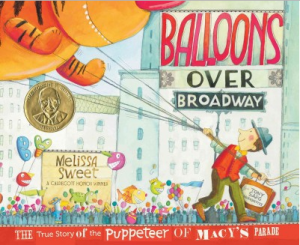
Balloons over Broadway: the True Story of the Puppeteer of Macy’s Parade by Melissa Sweet. Boston: Houghton Mifflin Books for Children, 2011.
A beautiful picture book biography highly recommended for anyone eight years old and up, although it’s connection to Thanksgiving will only be important for American readers. The flowing language makes it wonderful as a read-aloud and the style makes it useful for teaching writing techniques for older students.
Star Stuff: Carl Sagan and the Mysteries of the Cosmos by Stephanie Roth Sisson (New York : Roaring Brook Press, 2014). Highly recommended for ages 8-years-old and up.
Tate, Don. Strong as Sandow: How Eugen Sandow Became the Strongest Man on Earth. Watertown, MA: Charlesbridge, 2017.
Eugen was a weakling, small and puny, without any athletic ability to attract fame. Born in Prussia, his father took him to visit art galleries in Italy, where he was astonished at the physiques portrayed in the statues. Could he ever become as strong as those ancient athletes? While his father wanted him to strengthen his mind, he joined the circus in order to strengthen his body. By the time Eugen was in his early twenties, he was ready to challenge the strongest men in the world. In London in 1889, he reached his goal and sailed into the world of fame.
This beautifully written 40-page picture book biography by an award-winning illustrator and former bodybuilder is recommended for readers 8 to 14 years old. It includes a lengthy bibliography and additional information, including exercises to build strength. A great book for action-oriented students who like sports.
The Tree Lady: the True Story of How One Tree-loving Woman Changed a City Forever by H. Joseph Hopkins (New York: Beach Lane Books, 2013).
In the late 1800s, an American moved to San Diego in southern California. Kate Sessions decided her new city needed more greenery, so she planted hundred and hundreds of trees and taught countless people how to grow gardens. She became known as the Mother of Balboa Park.
Biblioburro: A True Story from Columbia by Jeanette Winter (Beach Lane Books, 2010).
The story of Luis Soriano, who loads up his burro with books and visits villages in Columbia.
When Stravinsky Met Nijinsky: Two Artists, Their Ballet, and One Extraordinary Riot by Lauren Stringer (Harcourt Children’s Books, 2013).
Su Dongpo by Demi (New York: Lee & Low Books, 2006).
A delicately detailed picture book biography of a civil engineer, poet, and statesman who exhibited courage, patience, and honour in 11th century China. Highly recommended for lovers of philosophy of all ages. [Authors; China; Su, Shi]
…
T
Westergaard, Azadeh. A Life Electric: The Story of Nikola Tesla. New York: Viking, 2021.
When people think of a Tesla, they think of a car that is very expensive. But who was the real Tesla? Was he wealthy?
Born in 1856 in a small village high in the mountains of what is now Croatia, young Nikola loved animals and books and coming up with inventions. When he was twenty-six, he he had a new idea: a motor that could send electric currents forward and backward along a wire. We now know that as alternating current and Nikola Tesla was the person who invented the AC induction motor. But even though he moved to America and patented many electrical inventions, he never became wealthy. Why? This picture book biography – with extensive additional information and a bibliography – provides the answer. It tells the story of a man with an incredible mind who became known for his kindness towards all living creatures. Highly recommended for readers 7 years old and up.
Jim Thorpe’s Bright Path by Joseph Bruchac (New York: Lee & Low Books, 2004).
Jim Thorpe is considered one of the most important American athletes in the 20th century. Over the course of his long career, he set records and won awards in many sports including football, baseball, track and swimming. This picture book biography of an aboriginal American from Oklahoma is highly recommended for readers 9-years-old and up.
My Name is Truth: the Life of Sojourner Truth by Ann Turner (New York: Harper, 2015).
“A vibrantly illustrated story of how former slave Isabella Baumfree transformed herself into the preacher and orator Sojourner Truth, one of the most inspiring and important figures of the abolitionist and women’s rights movements.” – CIP. Illustrated by the acclaimed James Ransome and accompanied by historical information at the end, this biography – told from the first person point of view – is highly recommended for readers 8-years-old and up.
…
W
Hubbard, Rita Lorraine. The Oldest Student: How Mary Walker Learned to Read. New York: Schwartz & Wade Books, 2020.
Once in a while, a book soars above all the rest. The illustrations convey emotions as well as plot details. The size and style of the font matches the tone of the story and the age of the intended readers. The words sing with the rhythm of a story told over and over aloud, and the design turns it all into a work of brilliance.
This picture book is brilliant right from the beginning. It tells the story of Mary Walker, born a slave in 1848 and growing up to labour in the cotton fields, toil in the Big House, and follow the rules: work, work, work. Do not learn to read. When Mary was fifteen years old, freedom came, but she was desperately poor and still had to work. Mary Walker married, gave birth to a son, was widowed, married again and gave birth to two more sons. Year after year, she kept working and working – and dreaming of being able to decipher the squiggles she saw on billboards and signs. Finally, when she was 114 years old, she decided it was time she learned how to read. And she did!
This inspiring picture book – illustrated by Oge Mora – is most highly recommended for all readers 8 years old and up.
His Name was Raoul Wallenberg by Louise Borden (Houghton Harcourt, 2012).
…
Fifty Cents and a Dream: Young Booker T. Washington by Jabari Asim (New York: Little, Brown and Co., 2012.
Finding Winnie: the True Story of the World’s Most Famous Bear by Lindsay Mattick (Toronto: HarperCollins Publishers Ltd, 2015).
“During World War I, Captain Harry Colebourn, a Canadian veterinarian rescued a bear cub on his way to Europe and took her to the war.” – CIP. Written by the great-granddaughter of Harry Colebourn, beautfully illustrated by Sophie Blackall, and accompanied by historical photographs, this thoughtful informative book is highly recommended for readers 8-years-old and up.
“‘Sometimes,’ I said, ‘you have to let one story end so the next one can begin.’
“‘How do you know when that will happen?’
“‘You don’t,’ I said. ‘Which is why you should always carry on.'”
…
Walker, Sally M. Winnie: The True Story of the Bear Who Inspired Winnie-the-Pooh. New York: Henry Holt and Company, 2015.
Winnie-the-Pooh is a lovable bear who lives with his friends in the Hundred Acre Wood. At least in the books. But who was the real Winnie?
This biography tells the story. Harry Colebourn, a Canadian veterinarian, adopted a bear cub which he took along when he was shipped overseas during World War I. Winnie became the regiment’s mascot, named after its hometown of Winnipeg, Manitoba. But when the soldiers were sent over to France, Winnie couldn’t go along. This picture book tells the story of what happened to the little bear and how it came to be known around the world.
Illustrated in pen and ink and watercolour by Jonathan D. Voss and accompanied by black and white photographs, this gentle book is recommended for all readers fond of the honey-loving ‘Bear of Very Little Brain.’
Winter, Jonah. Born and Bred in the Great Depression. New York: Schwartz & Wade Books, 2011.
The author tells the story of his father’s childhood in Texas during the 1930s. Told from the second person point of view, this beautifully designed picture book with pencil, ink, and watercolour illustrations by Kimberly Bulcken Root is accompanied by black and white photographs. Recommended for readers 8 years old and up.
Harshman, Marc and Anna Egan Smucker. Fallingwater: The Building of Frank Lloyd Wright’s Masterpiece. New York: Roaring Brook Press, 2017.
I like picture book biographies. I can expand my general knowledge of history in little snippets that stay in my memory, unlike longer books that give me far more details than I will ever remember. And picture books are generally beautifully written with illustrations that bring history to life.
Fallingwater is no exception. It is written – using present tense – in an elegantly simple style and enhanced by LeUyn Pham’s sophisticated illustrations. The author’s and artist’s notes at the end of the story will be of interest to readers who want to learn more about the famous house designed by American architect Frank Lloyd Wright.
Richard Wright and the Library Card by William Miller (Lee & Low Books, 1997).
Seventeen-year-old Richard, an African-American born in the 1920s, wants to learn how to read at a time when black people are not allowed to borrow books from libraries. [Books and reading; Libraries; Racism; Determination]
…
W
Yuksel, M.O. One Wish: Fatima al-Fihri and the World’s Oldest University. New York: Harper, an imprint of HarperCollinsPublishers, 2022.
This is a true story about a little girl from Tunisia who grew up to “build a school where students, especially the poor and the refugees, could live and study for free.” Fatima loved learning. Even after she and her family had to flee their home due to war, she continued to study. After her father and her husband died, leaving her a wealthy woman, she decided to use her fortune to help her new community in Morocco. She designed and supervised the building of an educational institution of higher learning to which students came from around the world. This university has now been in continuous operation for over one thousand years!
Brilliant illustrations by Miriam Quraishi help to tell this story, which is supplemented by additional information including a glossary, bibliography and timeline. Most highly recommended for all readers who like learning.
Z
Clean Sweep!: Frank Zamboni’s Ice Machine by Monica Kulling (Toronto: Tundra Books, 2016).
“A portrait of the inventor of the Zamboni ice-resurfacing machine recounts how the co-owner of a 1940s skating rink spent nine years designing and building machines that he hoped could safely and quickly shave down pits and grooves on ice.” – CIP. An informative picture book illustrated by Renné Benoit, which will appeal to skating and hockey fans 9-years-old and up.
…
More Reviews!
Did you know Lou Gehrig’s stamina got him the name nickname Iron Horse? Did you know that throughout 14 seasons as a New York Yankee he never missed a single game? Lou Gehrig, the Luckiest Man by David A. Alder (Gulliver Books, 1997) tells all sorts of unbelievable information about Lou Gehrig’s incredible career as a Yankee. I learned that the first ever baseball series was played in 1903. I also learned that Lou Gehrig attended Columbia University. I then discovered that after he signed, he played in 2130 consecutive professional baseball games and in 1927, Gehrig’s teammate and friend, Babe Ruth, hit 60 home runs in only one season! Lou Gehrig, the Luckiest Man is an amazing book about this famous athlete’s outstanding life as a baseball player. (Dane in grade eight)
Walters, Eric, ed. Tell Me Why: How Young People Can Change the World. Toronto: Doubleday Canada, 2008.
Twenty-five internationally known figures including Robert Munsch, Deborah Ellis, Roy MacGregor, Rick Hansen and Susan Aglukark answer these questions: Why do people sometimes treat each other so badly? Why are you willing to help people? And what can a young person do to make the world a better place? Then five young people are profiled, showing what they are doing to improve life for others on this planet. Inspirational quotations are interspersed in the wide margins, unfortunately creating more of a browsing book than one that readers can attentively read. Therefore, this admirable volume is probably best suited for teachers looking for short excerpts to use for lessons or for middle school or high school students doing research. [Conduct of life; Heroes; Social responsibility; Social action]
A response to: The Cornflake King: W.K. Kellogg and His Amazing Cereal by Edwin Brit Wyckoff (Enslow Publisher, 2011).
William Kellogg
1. Why are People Remembered?
I think people will be remembered by the way in which they lived. For example, if a person was generous and kind, they will be remembered as a generous and kind person. But, if a person is rude and obnoxious, they would be remembered as someone who was rude and obnoxious.
2. Destruction and Determination
On July 4, 1907, the factory that made cereal known in 160 different countries, Kellogg’s Factory, burned to the ground. William Kellogg, the King of Cornflakes, determined not to give up, borrowed money to rebuild the factory.
3. ” I Never Learned to Play”
William Kellogg was born to John Preston Kellogg and Mary Ann Call on April 7, 1860, in Battle Creek Michigan. He was a part of a poor family of 14 that still gave generously. His family helped many slaves into Canada and gave to neighbors in need. William went to school until grade 6, but could not continue because of his desperate need for glasses. He finally got glasses at age 20.
4. The Super Sales Man Sweeps Up
In 1867, 7-year-old Will started working in a broom factory his father set up. Once a teenager, his father put him in charge of the whole factory. Later, at age 15, Will was sent from town to town to sell brooms. On his first day, a giant snow storm flipped the wagon over spilling all the brooms into the snowbank. Will picked up all the brooms. This happened three times in a row that day! Then, at age 18, Will was offered a job managing a broom factory in Dallas, Texas. His boss was lazy and didn’t pay the bills, so Will went back home and married his girlfriend, Ella Davis, on November 3, 1880.
5. The Million Dollar Mistake
After going to business college, Will worked for his brother, who was a doctor for his church. William worked 15 hours a day for 25 years, following his bike-riding-brother and jotting down notes for him. Will later became the janitor, book keeper, technician, who packed and shipped all the books. One day Will found an old, non-refrigerated piece of dough and ran it through the hot rollers, and added sugar. Being a doctor, Will’s brother didn’t approve of the new sugary flakes. The two brothers argued and split up in 1906. Will started up his own business in Battle Creek and less than a year later was shipping 42 hundred cases of cornflakes a day. Will had the courage to spend $300,000 on newspaper ads in 1907. When the Great Depression hit, Will set up the factory with four 6-hour-shifts a day. By 1940, Kellogg’s spent more than 100 million in advertisements and was bringing in a billion dollars a year.
6. Investing in People
Now with a little money, Will built a nice house on a lake in Michigan, a mansion in Florida and a horse ranch in California. Will remembered his old horse Spot which was an Arabian so he bought 90 Arabian horses, which make fascinating race horses. Will always wanted a dog, so he bought some German Sheperds. Will paid off mortgages for people in need and paid doctor’s bills for people. Later, Will started the charity, W.K. Kellogg’s Foundation, which started with 66 million and grew to 8 billion dollars! William Kellogg died on October 6, 1951.
7. Good for Willy K.
It is a good thing William was born because he influenced and helped so many people. For example, he gave money to various people to help them keep their houses or get medical care. If you think about it, if Will had not helped those people pay their medical bills, they could have died and they wouldn’t have any descendants, which means their families wouldn’t be here today. And if those families weren’t here, the population would be smaller, and there would be less stores, which means there would be fewer products. Fewer products means unhappy people, which equals fighting, which would lead to wars, which could lead to a world war and many people would die. Good thing William Kellogg was generous.
8. How I could be Like William
I could be more like William Kellogg by happily, not reluctantly, lending things to people. For example, if someone asks if they could borrow a pencil, I could practice happily giving it to them instead of ignoring them. Another thing I could do to be more like Will is to learn from others’ mistakes. For example, if someone gets in trouble for talking, I should try my best to not talk because it is the right thing to do and if I get caught talking again, I will have an even bigger negative consequence, besides I shouldn’t be talking in the first place. Another thing I can learn from Will is to never give up. Will’s factory burned down and he did whatever it took to get the factory running again. I could defiantly learn some things from William Kellogg. (Tyler)

